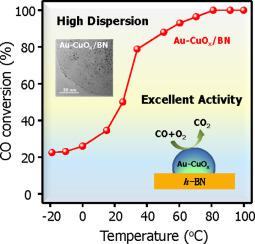当前位置:
X-MOL 学术
›
Chin. J. Catal.
›
论文详情
Our official English website, www.x-mol.net, welcomes your
feedback! (Note: you will need to create a separate account there.)
Highly dispersed boron-nitride/CuO -supported Au nanoparticles for catalytic CO oxidation at low temperatures
Chinese Journal of Catalysis ( IF 15.7 ) Pub Date : 2021-03-01 , DOI: 10.1016/s1872-2067(20)63669-5 Fan Wu , Lei He , Wen-Cui Li , Rao Lu , Yang Wang , An-Hui Lu
Chinese Journal of Catalysis ( IF 15.7 ) Pub Date : 2021-03-01 , DOI: 10.1016/s1872-2067(20)63669-5 Fan Wu , Lei He , Wen-Cui Li , Rao Lu , Yang Wang , An-Hui Lu

|
Abstract Supported-Au catalysts show excellent activity in CO oxidation, where the nature of the support has a significant impact on catalytic activity. In this work, a hexagonal boron nitride (BN) support with a high surface area and adequately exposed edges was obtained by the ball-milling technique. Thereafter, impregnation of the BN support with Cu(NO3)2 followed by calcination under air at 400 °C yielded a CuO-modified support. After Au loading, the obtained Au-CuOx/BN catalyst exhibited high CO oxidation activity at low temperatures with a 50% CO conversion temperature (T50%) of 25 °C and a complete CO conversion temperature (T100%) of 80 °C, well within the operational temperature range of proton exchange membrane fuel cells. However, the CO oxidation activity of Au/BN, prepared without CuOx for comparison, was found to be relatively low. Our study reveals that BN alone disperses both Cu and Au nanoparticles well. However, Au nanoparticles on the surface of BN in the absence of CuO species tend to aggregate upon CO oxidation reactions. Conversely, Au nanoparticles supported on the surface of CuO-modified BN remain small with an average size of ∼2.0 nm before and after CO oxidation. Moreover, electron transfer between Au and Cu species possibly favors the stabilization of highly dispersed Au nanoparticles on the BN surface and also enhances CO adsorption. Thus, our results demonstrate that thermally stable and conductive CuO-modified BN is an excellent support for the preparation of highly dispersed and stable Au catalysts.
中文翻译:

高度分散的氮化硼 / CuO 负载的 Au 纳米粒子用于低温催化 CO 氧化
摘要 负载型金催化剂在 CO 氧化中表现出优异的活性,其中载体的性质对催化活性有显着影响。在这项工作中,通过球磨技术获得了具有高表面积和充分暴露边缘的六方氮化硼 (BN) 载体。此后,用 Cu(NO3)2 浸渍 BN 载体,然后在 400°C 下在空气中煅烧,得到 CuO 改性的载体。Au负载后,所得Au-CuOx/BN催化剂在低温下表现出较高的CO氧化活性,50%的CO转化温度(T50%)为25℃,CO完全转化温度(T100%)为80℃,完全在质子交换膜燃料电池的工作温度范围内。然而,发现在没有用于比较的 CuOx 的情况下制备的 Au/BN 的 CO 氧化活性相对较低。我们的研究表明,单独的 BN 可以很好地分散 Cu 和 Au 纳米颗粒。然而,在不存在 CuO 物种的情况下,BN 表面上的 Au 纳米颗粒倾向于在 CO 氧化反应中聚集。相反,负载在 CuO 改性 BN 表面的 Au 纳米粒子在 CO 氧化前后保持较小,平均尺寸约为 2.0 nm。此外,Au 和 Cu 物种之间的电子转移可能有利于 BN 表面上高度分散的 Au 纳米粒子的稳定化,并增强 CO 吸附。因此,我们的结果表明,热稳定且导电的 CuO 改性 BN 是制备高度分散且稳定的 Au 催化剂的极好载体。在不存在 CuO 物种的情况下,BN 表面上的 Au 纳米颗粒倾向于在 CO 氧化反应中聚集。相反,负载在 CuO 改性 BN 表面的 Au 纳米粒子在 CO 氧化前后保持较小,平均尺寸约为 2.0 nm。此外,Au 和 Cu 物种之间的电子转移可能有利于 BN 表面上高度分散的 Au 纳米颗粒的稳定化,并增强 CO 吸附。因此,我们的结果表明,热稳定且导电的 CuO 改性 BN 是制备高度分散且稳定的 Au 催化剂的极好载体。在不存在 CuO 物种的情况下,BN 表面上的 Au 纳米颗粒倾向于在 CO 氧化反应中聚集。相反,负载在 CuO 改性 BN 表面的 Au 纳米粒子在 CO 氧化前后保持较小,平均尺寸约为 2.0 nm。此外,Au 和 Cu 物种之间的电子转移可能有利于 BN 表面上高度分散的 Au 纳米粒子的稳定化,并增强 CO 吸附。因此,我们的结果表明,热稳定且导电的 CuO 改性 BN 是制备高度分散且稳定的 Au 催化剂的极好载体。Au和Cu物种之间的电子转移可能有利于BN表面上高度分散的Au纳米颗粒的稳定化,并且还增强了CO吸附。因此,我们的结果表明,热稳定且导电的 CuO 改性 BN 是制备高度分散且稳定的 Au 催化剂的极好载体。Au和Cu物种之间的电子转移可能有利于BN表面上高度分散的Au纳米颗粒的稳定化,并且还增强了CO吸附。因此,我们的结果表明,热稳定且导电的 CuO 改性 BN 是制备高度分散且稳定的 Au 催化剂的极好载体。
更新日期:2021-03-01
中文翻译:

高度分散的氮化硼 / CuO 负载的 Au 纳米粒子用于低温催化 CO 氧化
摘要 负载型金催化剂在 CO 氧化中表现出优异的活性,其中载体的性质对催化活性有显着影响。在这项工作中,通过球磨技术获得了具有高表面积和充分暴露边缘的六方氮化硼 (BN) 载体。此后,用 Cu(NO3)2 浸渍 BN 载体,然后在 400°C 下在空气中煅烧,得到 CuO 改性的载体。Au负载后,所得Au-CuOx/BN催化剂在低温下表现出较高的CO氧化活性,50%的CO转化温度(T50%)为25℃,CO完全转化温度(T100%)为80℃,完全在质子交换膜燃料电池的工作温度范围内。然而,发现在没有用于比较的 CuOx 的情况下制备的 Au/BN 的 CO 氧化活性相对较低。我们的研究表明,单独的 BN 可以很好地分散 Cu 和 Au 纳米颗粒。然而,在不存在 CuO 物种的情况下,BN 表面上的 Au 纳米颗粒倾向于在 CO 氧化反应中聚集。相反,负载在 CuO 改性 BN 表面的 Au 纳米粒子在 CO 氧化前后保持较小,平均尺寸约为 2.0 nm。此外,Au 和 Cu 物种之间的电子转移可能有利于 BN 表面上高度分散的 Au 纳米粒子的稳定化,并增强 CO 吸附。因此,我们的结果表明,热稳定且导电的 CuO 改性 BN 是制备高度分散且稳定的 Au 催化剂的极好载体。在不存在 CuO 物种的情况下,BN 表面上的 Au 纳米颗粒倾向于在 CO 氧化反应中聚集。相反,负载在 CuO 改性 BN 表面的 Au 纳米粒子在 CO 氧化前后保持较小,平均尺寸约为 2.0 nm。此外,Au 和 Cu 物种之间的电子转移可能有利于 BN 表面上高度分散的 Au 纳米颗粒的稳定化,并增强 CO 吸附。因此,我们的结果表明,热稳定且导电的 CuO 改性 BN 是制备高度分散且稳定的 Au 催化剂的极好载体。在不存在 CuO 物种的情况下,BN 表面上的 Au 纳米颗粒倾向于在 CO 氧化反应中聚集。相反,负载在 CuO 改性 BN 表面的 Au 纳米粒子在 CO 氧化前后保持较小,平均尺寸约为 2.0 nm。此外,Au 和 Cu 物种之间的电子转移可能有利于 BN 表面上高度分散的 Au 纳米粒子的稳定化,并增强 CO 吸附。因此,我们的结果表明,热稳定且导电的 CuO 改性 BN 是制备高度分散且稳定的 Au 催化剂的极好载体。Au和Cu物种之间的电子转移可能有利于BN表面上高度分散的Au纳米颗粒的稳定化,并且还增强了CO吸附。因此,我们的结果表明,热稳定且导电的 CuO 改性 BN 是制备高度分散且稳定的 Au 催化剂的极好载体。Au和Cu物种之间的电子转移可能有利于BN表面上高度分散的Au纳米颗粒的稳定化,并且还增强了CO吸附。因此,我们的结果表明,热稳定且导电的 CuO 改性 BN 是制备高度分散且稳定的 Au 催化剂的极好载体。











































 京公网安备 11010802027423号
京公网安备 11010802027423号